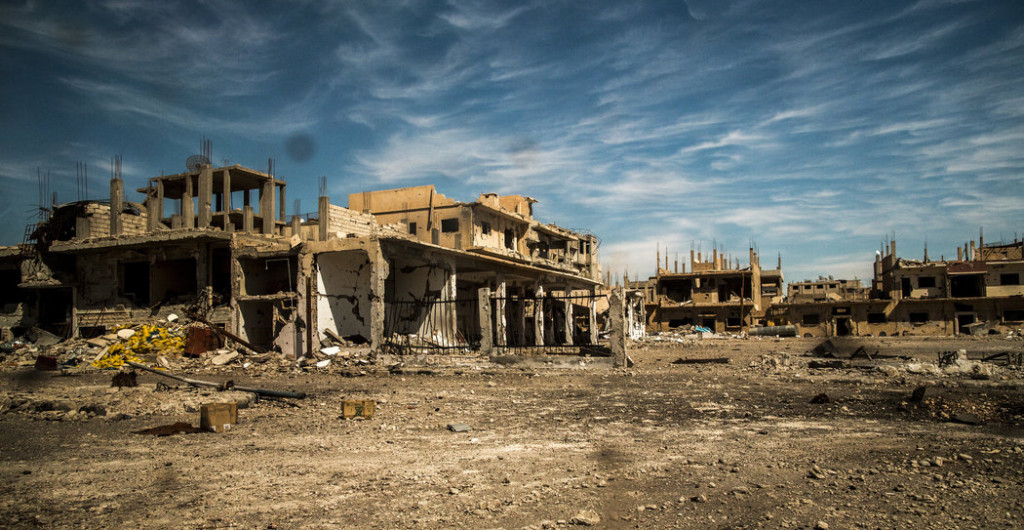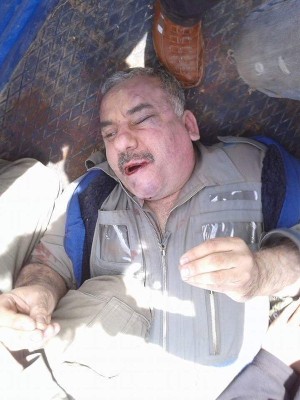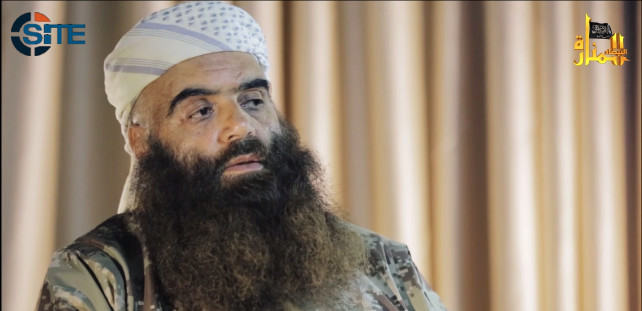PHOTO: Abu Firas was a member of Jabhat al-Nusra’s policy-making Shura Council
LATEST
- Regime: Rebels Used Anti-Aircraft Missile to Down Jet Fighter
- Regime: Rebels Used Anti-Aircraft Missile to Down Jet Fighter
- Journalist: Pro-Assad Troops Prevent Residents from Returning to Palmyra
- UN Calls for Medical Evacuation from Besieged Towns After More Deaths
- Rebels: We Downed Regime Warplane in Aleppo Province
- Fighting Resumes Between Kurdish YPG Militia and Rebels in Aleppo Province
- Regime Sniper “Assassinates” Zabadani’s Last Doctor
- Report: Kurdish-Led SDF Fires on Protesters, Kills 15-Year-Old
- Human Rights Watch: Aid Still Cut Off to Damascus Suburbs
- State Media: ISIS Used Mustard Gas on Regime Troops
TUESDAY FEATURES
The Panama Papers and Assad’s Tycoon CousinThe Importance of Refugees and Their Stories
American officials have confirmed that the US carried out an airstrike in northwest Syria that killed a prominent Jabhat al-Nusra commander and more than 20 jihadists of Nusra and its ally Jund al-Aqsa.
The drone strike on Sunday in Idlib Province targeted Abu Firas al-Suri, a former Syrian Army officer who joined mujahideen fighters in Afghanistan in the 1980s. He was part of Al Qa’eda’s operations in Yemen before entering the Syrian conflict and becoming a senior member of Nusra’s Shura Council.
Pentagon spokesman Peter Cook said said the airstrike hit a meeting of “high-level” officials. He said officials were still confirming whether Abu Firas had been killed.
Other US officials declined to say whether the missile was fired by manned aircraft or a drone. Rebel sources said on Sunday that a drone was responsible, while a Nusra member said that the attack “was engineered by the Crusader axis”.
The US has periodically attacked Nusra since it began aerial operations in Syria in September 2014. In the past, it has said the airstrikes are trying to disrupt the “Khorasan Group”, which Washington claims is planning attacks in the US and Europe.
Regime: Rebels Used Anti-Aircraft Missile to Down Jet Fighter
The Syrian military has said that rebels used a surface-to-air missile to down a Su-22 jet fighter in Aleppo Province on Tuesday.
The rebel faction Ahrar al-Sham has said that it carried out the strike, but declined to say whether it used a portable MANPADS anti-aircraft missile.
The US has insisted that surface-to-air missiles not be supplied to rebels, but MANPADS are suspected in a mid-March downing of an Su-21 warplane as well as as today’s incident.
See earlier entry: Rebels Down Regime Warplane in Aleppo Province
Journalist: Pro-Assad Troops Prevent Residents from Returning to Palmyra
At the bottom of his first-hand story and photographs of Palmyra, the Roman-era city recaptured by pro-Assad forces 10 days ago from the Islamic State, the New York Times’ Bryan Denton notes:
Despite the Islamic State’s efforts, many of the ancient sites in Palmyra were undamaged. The destruction in the modern parts of Tadmur was far worse. Shops, cafes and houses in the city appeared to have been abandoned, empty of any signs of the once-vibrant city life in Syria.
Syrian soldiers and allied militiamen said that if residents were allowed to return to the city, Islamic State fighters might come back with them, and attempt to re-establish their presence in the city.

UN Calls for Medical Evacuation from Besieged Towns After More Deaths
The UN has called for medical evacuations from besieged towns after more civilians deaths.
Three children, injured by a regime landmine, and a young man have died in opposition-held Madaya in Damascus Province in the past week.
“The reported tragic death of a young Syrian man in the besieged town of Madaya is yet another sad event where medical evacuations have not been available for those in need,” UN spokesman Stephane Dujarric said.
He continued, “The UN called on all parties to the conflict to facilitate medical evacuation of the sick and wounded in a timely and systematic manner everywhere in Syria.”
The Syrian military and Hezbollah have blockaded Madaya since last July, cutting off supplied and shooting at residents who gathered firewood and foraged for food. More than 70 civilians died between December 1 and mid-January, before the Assad regime relented and allowed a limited amount of aid into the town.
Rebels Down Regime Warplane in Aleppo Province
Rebels have shot down a regime warplane which crashed in Aleppo Province on Tuesday.
A Syrian military source confirmed to the Russian outlet RIA Novosti, “The Syrian Air Force plane was shot down by militants in the Aleppo province during a combat mission. At the moment, we are trying to find out the fate of the pilot.”
The rebel faction Ahrar al-Sham claimed that it downed the warplane. The Su-22 jet fighter was reportedly attacking rebels near al-Eis, the town on the southern Aleppo front which they recaptured last Friday in an offensive that surprised pro-Assad forces. An activist said it crashed near the village of Al-Bawabiya, about 35 km (22 miles) southwest of Aleppo.
The jihadists of Jabhat al-Nusra say they captured the pilot — identified by pro-regime outlets as Khaled Said of Latakia — circulating a photograph:

Rebels are not saying whether they downed the jet with a shoulder-launched MANPADs anti-aircraft missile. Three weeks ago, a Su-21 jet was downed in Hama Province, but the weapon used by Jaish al-Islam is still unknown.
The US has officially ruled out supply of anti-aircraft weapons to rebel factions.
مكان سقوط الطائرة الحربي في ريف #حلب الجنوبي اليوم pic.twitter.com/8JTrTbjJNk
— الاعلامي انس معراوي (@anasanas84) April 5, 2016
The Su-22 bursting into flames:
The pilot parachuting to the ground:
شاهد | هبوط أحد الطيارين بعد اسقاط الثوار طائرته في ريف #حلب الجنوبي#سوريا pic.twitter.com/Ced8Ty4jF8
— AMC FM (@RadioAMCFM) April 5, 2016
Fighting Resumes Between Kurdish YPG Militia and Rebels in Aleppo Province
Fighting has resumed between the Kurdish YPG militia and rebels in Aleppo Province.
Rebel outlets say the latest clashes began when the YPG tried to seize the al-Castello road leading into Aleppo. Activists also say that the YPG is again attacking the key town of Azaz on the Turkish border, and that there is fighting in the Sheikh Maqsoud district of Aleppo city.
Kurdish outlets report that several civilians have been killed and others wounded by shelling in Sheikh Maqsoud.
Last month, the YPG seized territory in Aleppo Province from rebels, including towns such as Tal Rifaat and Deir Jamal. The Kurdish militia’s assault on Azaz was checked by Turkish shelling.
Skirmishes in Sheikh Maqsoud have continued despite the February 27 cessation of hostilities. T
ension may also be raised by a race by each side to take territory from the retreating Islamic State along the Turkish border. Rebels are moving on the town of Jarablus from the west, while the Kurdish-led Syrian Democratic Forces are advancing from the east.
Turkey has warned the SDF and its US backers from any attempt to take Jarablus.
Regime Sniper “Assassinates” Zabadani’s Last Doctor
The last doctor in opposition-held Zabadani in Damascus Province has been killed by a regime sniper, according to his nephew.
Muhammad al-Khoud, 71, was shot as he was leaving his hospital. It took three hours to remove the body because of the continued threat of snipers.
“[He] studied medicine in Germany and was not only the most famous, but the last doctor in Zabadani,” said Amer Burhan, al-Khoud’s nephew and director of the opposition’s medical organization in Zabadani. “There is one pharmacist left who helped the doctor during surgery. Now he is the only alternative, but he can only perform basic first aid.”
Burhan asserted, “We consider it an assassination since they knew that targeting him would exacerbate the medical situation since he was the only doctor.”
Zabadani was attacked for almost three months last summer by Hezbollah and the Syrian military, but the town held out until a ceasefire was agreed in October.
Civilians have now been evacuated, leaving about 500 men in the town, which is still besieged and under sniper fire.
“We are in a situation where we can’t respond to any truce violation and are at the point of starvation due to the blockade. Also, there aren’t any animals we can eat in the town,” said Burhan.
Report: Kurdish-Led SDF Fires on Protesters, Kills 15-Year-Old
Kurdish-led Syrian Democratic Forces have opened fire on a protest march by Arab residents in a village in eastern Syria, killing a 15-year-old and wounding dozens of people, according to a citizen journalist.
The 3,000 protesters marched three km (1.9 miles) on Saturday morning from a makeshift camp in the Hasakah desert to their village of al-Hawl, “demanding to be allowed to return to their homes”, Siraj al-Hasakawi told Syria Direct.
The villagers fled al-Hawl, 34 km (21 miles) southeast of Hasakah city, in February 2014 when Islamic State forces captured the village from the Free Syrian Army and Ahrar al-Sham. Last November, the SDF, backed by US airstrikes, moved into al-Hawl.
Since then al-Hawl’s former residents, more than 10,000 of whom live in tents in a settlement on the road to Hasakah city, have organized seven protests calling on the SDF to grant them the right to return.
Al-Hasakawi said the SDF tries to disperse the demonstrators with water hoses. However, last weekend, they “opened fire with live ammunition”. He said the forces then began arresting leaders from the Khawatinah tribe, one of the largest in Hasakah Province.
“We heard of this incident and are preparing an investigation into the issue,” SDF spokesman Major Talal Silo said on Monday. He said villagers were not allowed to return “for their own safety…given that the area is full of mines and explosives”.
Footage of the protest:
#Syria #YPG using bulldozers against peaceful protesters in al-Hawl #hasaka pic.twitter.com/p4zYnHx5tO
— Putintintin (@putintintin1) April 4, 2016
Human Rights Watch: Aid Still Cut Off to Damascus Suburbs
The Assad regime is still blocking aid to besieged Damascus suburbs, according to Human Rights Watch.
Quoting local council officials and aid workers in Darayya and Douma, HRW reported on Monday that civilians are suffering from “severe shortages of food and medicine as well as debilitating poverty”.
Under a February 27 cessation of hostilities, sieges are to be lifted by all sides. However, the head of the UN’s aid operations, Stephen O’Brien, confirmed two weeks ago that the regime continues to refuse access to at least six out of 18 areas. More than 250,000 civilians are affected in Douma, Darayya, Harasta, Erbin, Zamalka, and Zabadin.
Mohamed Shehateh, a member of the Darayya local council, said that there is no running water or electricity and most people are growing food like spinach and beans in their gardens to survive:
We used to depend on reserves and we could bring food in from the neighboring town but since the government tightened the siege we cannot bring in any food or medicine….
Many times we have to use expired medicine. There is only one field hospital to serve the whole city and they can’t perform many operations because of a lack of equipment.
A local aid worker in Douma, Abdullah al-Shami, echoed:
People in Douma aren’t able to buy the basics like bread and rice because we can’t afford it. Medicine is also scarce and finding the right treatment for sick people is almost impossible because there are no hospitals here.
Darayya, southwest of Damascus, has been cut off since late 2012 while Douma, to the northeast of the capital, has been besieged since October 2013.

A protest by women and children in Darayya in March
State Media: ISIS Used Mustard Gas on Regime Troops
Syrian State media claims that the Islamic State attacked regime troops with mustard gas in an offensive against Deir ez-Zor military airport in eastern Syria.
State outlets did not detail casualties in Monday’s ISIS rocket attack, the latest in a series of assaults on the heavily-defended airport.
ISIS-linked Amaq news agency said Islamic State fighters attacked the nearby village of Jufrah, with two vehicle-borne suicide bombs causing “tens of dead”.
Most of Deir ez-Zor city is held by the Islamic State, although the Syrian military retains some sections. The fighting has cut off supplies to about 200,000 residents in the area.
The Islamic State used mustard gas on at least two occasions against rebels in northern Syria last summer.

